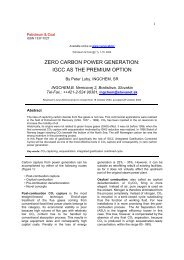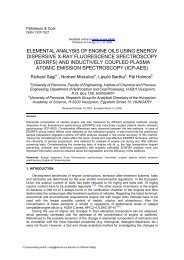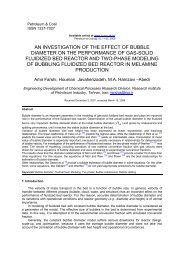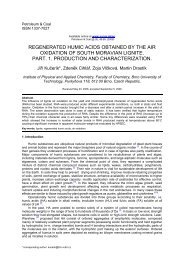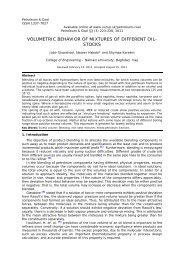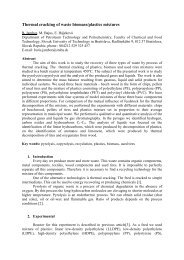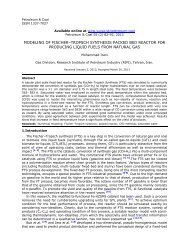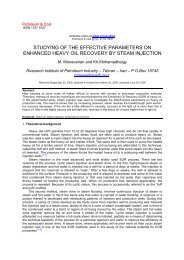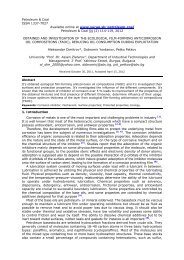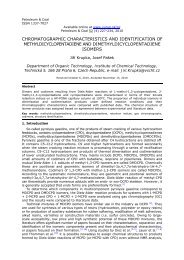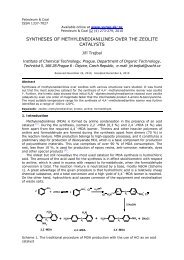reliability assessment of offshore jacket structures in niger delta
reliability assessment of offshore jacket structures in niger delta
reliability assessment of offshore jacket structures in niger delta
Create successful ePaper yourself
Turn your PDF publications into a flip-book with our unique Google optimized e-Paper software.
Where R(t) and P f (t) represent member <strong>reliability</strong> and probability <strong>of</strong> failure respectivelyEquation (2) can be written <strong>in</strong> term <strong>of</strong> member <strong>in</strong>itial thickness and time variant corrosionwastage, as shown <strong>in</strong> Equation (2) and (3).R( t)= T − Pf ( Δt)(2)ΔtR( t)= 1−(3)TWhere, T represents <strong>in</strong>itial member thickness and ∆t – thickness loss due to corrosion.2.1.2 Series Reliability ModelThe system <strong>reliability</strong> estimation as illustrated <strong>in</strong> Figure (2) can be represented <strong>in</strong>Equation (4) [7] .R s t = R p . R p . R p . R p(4)()() ( ) ( ) ( ) ( )ABCDwhere R A , R B , R C and R D represent the <strong>reliability</strong> <strong>of</strong> components A, B, C, and D, QA, QB,QC, and QD represents the probability <strong>of</strong> failure <strong>of</strong> A, B, C, and D. The success <strong>of</strong> thesystem (S) can be represented <strong>in</strong> terms <strong>of</strong> Boolean logic <strong>in</strong> equation (5):S = A ∩ B ∩ C ∩ D(5)The <strong>reliability</strong> or probability <strong>of</strong> success <strong>of</strong> the systems is:RS = RA . RB . RC . RD(6)For n components <strong>in</strong> series, it is written as:R R . R . R R − − − −(7)S=1 2 3.4R nThe characteristics <strong>of</strong> series systems are that the greater the number <strong>of</strong> the components,the lower the system <strong>reliability</strong> while the least reliable component <strong>in</strong> the system will determ<strong>in</strong>ethe overall <strong>reliability</strong> <strong>of</strong> the system.2.1.3 Parallel <strong>reliability</strong>M.A. Salau, D.E. Esezobor, M. F. Omotoso/Petroleum & Coal 53 (4) 291-301, 2011 293Parallel <strong>reliability</strong> system is designed with redundant components. This is <strong>of</strong>ten donewhen <strong>reliability</strong> <strong>of</strong> a system may be low as time goes on due to material degradation [9]as it is applicable to <strong>jacket</strong> brac<strong>in</strong>g structural members sited <strong>in</strong> a corrosive environment.However, parallel systems may either be Active or Stand-by Parallel system.For Active Parallel System, the whole components are active at all times. For a StandbyParallel System, some <strong>of</strong> the components will be stand<strong>in</strong>g-by <strong>in</strong> a ready state to act <strong>in</strong>place <strong>of</strong> failed ones. Figure 3 shows active parallel systems, where component A and Bare active at all times. The system is believed to be operat<strong>in</strong>g at all times under one <strong>of</strong>the follow<strong>in</strong>g conditions: (1) A and B is both operat<strong>in</strong>g, (2) Item A is operat<strong>in</strong>g and B hasfailed, (3) Item B is operat<strong>in</strong>g and A has failed. But when both A and B fail, then thesystem is considered a failure.INPUTP AP BP CP DOUTPUTFigure 2 Schematic <strong>of</strong> Four Pipes Series Reliability DiagramAINPUTINPUTBFigure 3 Diagram <strong>of</strong> an Active Parallel SystemThe calculation for the <strong>reliability</strong> <strong>of</strong> active parallel <strong>reliability</strong> system is expressed <strong>in</strong> Eq. (8).R ( s ) = R ( a ) + R ( b ) − R ( a ).R ( b )(8)where: R(s) is the <strong>reliability</strong> <strong>of</strong> the system, R(a) and R(b) are the reliabilities <strong>of</strong> the systemcomponents.



